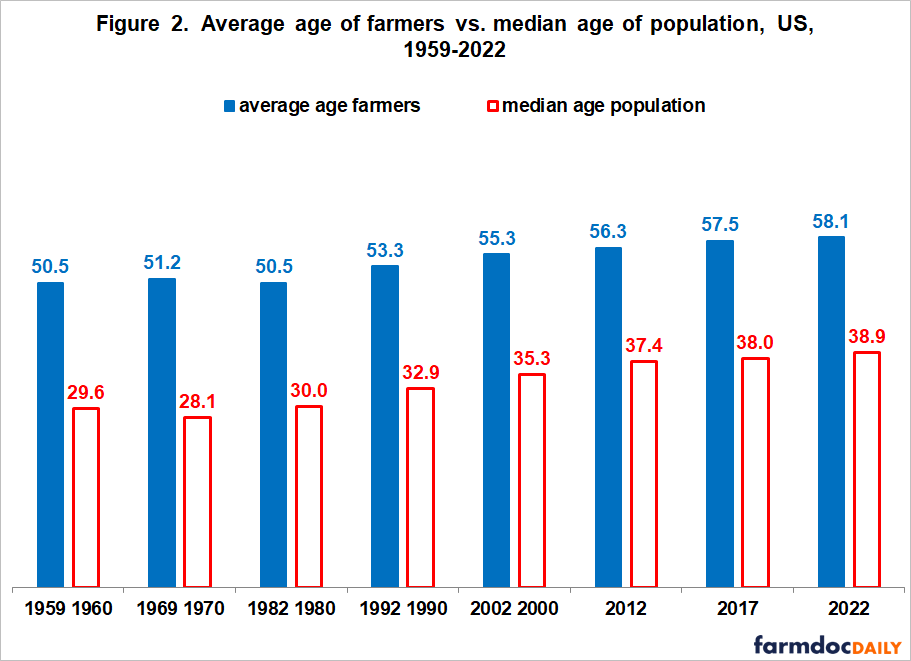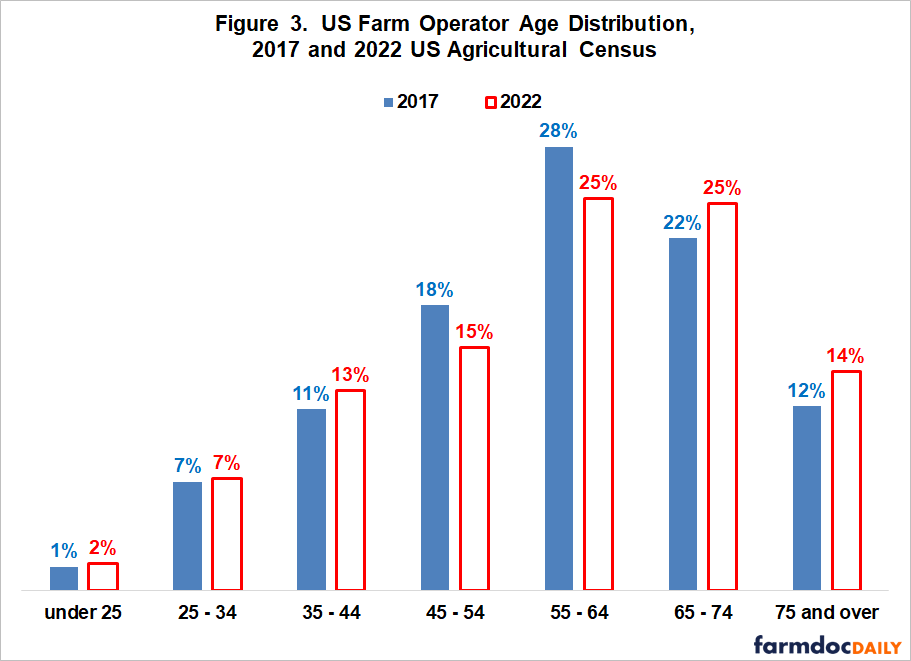Age of US Farmers: Not a Problem
The older age of US farmers remains a topic of concern (see, for example, US Senate Committee on Aging). The 2022 Census of Agriculture confirms that US farmers continue to age (farmdoc daily. October 23, 2013 and February 26, 2020, and Zulauf, 2021). However, US farmers are also becoming younger relative to the US population, and the age distribution of US farmers is consistent with more farmers entering the profession when economic returns are good. In total, this evidence is not consistent with the US having either a farmer aging or a farmer replacement problem.
Average Age
According to the 2022 Census of Agriculture, the average age of US farmer is 58.1, 0.6 years older than in the 2017 Census and 9.4 years older than in the 1945 Census, the first to report an average age (see Figure 1). Only in the 1978 and 2012 Census was average age more than 0.1 years younger than in the prior Census (50.3 vs. 51.7, 1978 vs. 1974; and 56.3 vs. 57.1, 2012 vs. 2007).
Relative Age
Age is both a level and relative concept. Relative to the US population, US farmers have become slightly younger over the last 60 years. Since 1960, the average age of US farmers has increased 7.6 years while the median age of the US population has increased 8.8 years (see Figure 2). US median age is from Korhonen and US Census Bureau. (Note, the Agricultural Census does not report a median age.)
Age Distribution
The share of US farmers between 45 and 64 was lower in the 2022 vs. the 2017 Census (see Figure 3). In contrast, the shares less than 45 and older than 65 increased from 19% to 22% and from 34% to 39%, respectively. Farmers older than 65 align with the 1970 period of prosperity while farmers younger than 45 align with the post-2006 period of prosperity (farmdoc daily, November 8, 2023). As economics would predict, more people enter farming when economic returns are good.
Involvement in Day-to-Day Decisions
In the 2022 Census, 85% of US farmers who are older than 65 reported that they are involved in day-to-day farming decisions. The share was nearly the same for farmers who are younger than 65 (86%).
Discussion
Average age of US farmers has increased over time, including in the 2022 Census of Agriculture.
US farmers have been and remain older than the US population. A likely reason is that farming requires inputs other than labor. Capital is required to buy farm equipment and rent or own farmland. Capital accumulation happens over a person’s lifetime.
Over the last half century, US farmers have become younger, not older, relative to the US population.
The current age distribution of US farmers is consistent with the expectation that more people enter farming when economic returns are good. US farm prosperity since 2006 (farmdoc daily, November 8, 2023) has been associated with an increase in share of US farmers younger than 45.
These observations do not suggest the US has a farmer aging or a farmer replacement problem.
Democracies get to choose what problems they wish to identify as political issues even if the evidence is that it is not an issue. What can be asked is that the issue be framed appropriately. Is the US farmer age issue an age issue or an entry issue? If an entry issue, is the entry issue for individuals raised on a farm or on a nonfarm? The answers to these questions are not clear. Thus, it is not clear what should be US public policy in this area.
Moreover, the large share of US farmers who remain active farmers after reaching the usual retirement age suggests US farmer age policy should also focus on helping older farmers remain highly productive members of a profession they love. This policy goal can be accomplished by investing public dollars in developing technology that helps older farmers remain active farmers as well as in extension programs targeted at helping older farmer adapt effectively to the aging process.
farmdoc daily Articles about the Age of US Farmers
Zulauf, C. “Putting the Age of U.S. Farmers in Perspective.” farmdoc daily (3):202, Department of Agricultural and Consumer Economics, University of Illinois at Urbana-Champaign, October 23, 2013.
Zulauf, C. “Age of US Farmers: Is the Wrong Issue Being Addressed?” farmdoc daily (10):35, Department of Agricultural and Consumer Economics, University of Illinois at Urbana-Champaign, February 26, 2020.
Other References and Data Sources
Korhonen, V. June 2, 2023. Median age of the U.S. population 1960-2021. Statista. https://www.statista.com/statistics/241494/median-age-of-the-us-population/
US Census Bureau. June 22, 2023. America is Getting Older: New Population Estimates Highlight Increase in National Median Age. Press Release Number CB23-106. https://www.census.gov/newsroom/press-releases/2023/population-estimates-characteristics.html
US Department of Agriculture, National Agricultural Statistics Service. April 2024. Census of Agriculture: 1945-2022. https://www.nass.usda.gov/AgCensus/index.php
US Senate Committee on Aging, Senator Mike Braun, Ranking Member,. October 2023. Farmers are America’s oldest workforce. How are we preparing for the next generation? https://www.aging.senate.gov/imo/media/doc/senate_aging_farmers_report.pdf
Zulauf, C. 2021. “Farmers.” Handbook of Rural Aging. Editor: Lenard W. Kaye. New York, NY: Routledge. Pages 160-164.
Zulauf, C. and G. Schnitkey. “The Post 2006 New Normal: US Grain and Oilseed Profitability.” farmdoc daily (13):204, Department of Agricultural and Consumer Economics, University of Illinois at Urbana-Champaign, November 8, 2023.
Disclaimer: We request all readers, electronic media and others follow our citation guidelines when re-posting articles from farmdoc daily. Guidelines are available here. The farmdoc daily website falls under University of Illinois copyright and intellectual property rights. For a detailed statement, please see the University of Illinois Copyright Information and Policies here.










